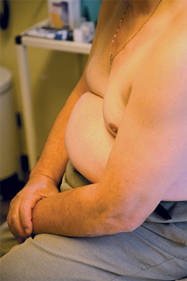Group visits bring focus and control to hypertension
A VA center reduced uncontrolled hypertension rates by implementing group visits. The program allowed physicians to titrate medicine to efficacy, and then motivated patients to remain involved and compliant with therapy.
Where: Michael E. DeBakey Veterans Affairs Medical Center (MEDVAMC), a large regional health center in Houston.
The issue: Reducing the rate of uncontrolled hypertension among primary care patients.
Background

From October 2004 to May 2005, primary care clinicians at MEDVAMC saw more than 20,000 patients with diagnosed hypertension. Only slightly more than half of the patients without diabetes had achieved control of their hypertension, and rates were even lower among diabetics.
Hypertension control was impeded by a number of factors that are likely also familiar to other physicians, according to Aanand D. Naik, MD, a clinical investigator at the Houston Health Services VA Research and Development Center of Excellence and a geriatrician at MEDVAMC.
“The way we've been taught to manage blood pressure, it's a chronic thing. You go slow and you titrate gradually and you watch it over time,” he said. “But the problem is no patient remains that motivated over that longer period of time.”
Slow management can also make treatment decisions more difficult. “When you're getting one or two readings every six months, it's hard to know. The blood pressure we're getting in the office is different from what they're saying they're getting at home. You're not sure about what level of blood pressure the patient is actually at,” Dr. Naik said.
Physicians may also attribute lack of control to patient nonadherence to medication regimens. “That's what drove us to go this [induction group visit] approach, to tackle some of those presumptions,” Dr. Naik said.
How it works
The MEDVAMC approach involved group visits every two weeks for six weeks for patients with uncontrolled hypertension. At each visit, patients' blood pressure was measured in a standardized manner. If the reading was above the pre-established goal, antihypertensive treatment was escalated, unless adverse effects were reported.
“We instructed clinicians to titrate until the patient says, ‘I'm having a side effect’ or you get a side effect from a blood test, like the electrolytes are off or the creatinine bumps or the patient complains of postural hypotension. One unexpected finding in the study was that the rate of side effects was very low and almost no patients reported medication-related side effects. It's an issue a lot of doctors worry about but not something that was not an issue at all in our program,” said Dr. Naik.
In addition to individual titration with a clinician, the visits also entail group discussion. “They talk about their experiences with the medication. It encourages them to ask questions when questions arise,” Dr. Naik said.
The frequency and focus of the visits change the typical dynamic of hypertension care, according to Dr. Naik. “It focuses motivational attention both on the patients' and the physicians' sides in a relatively short period of time. You're coming for this one purpose. There's not a lot of competing demands.”
And for physicians who already have too many demands on their time, another benefit of the system is that nonphysicians can handle most of the work within predefined limits.
“A lot of this can be done by nurses or other office staff who are trained to do the measurement of the blood pressure. You can make the titration algorithmic to some extent, really minimizing the amount of time required by the physician. Just when patients are having trouble with the algorithm or they're falling off the algorithm, that's when you might need a physician's involvement,” said Dr. Naik.
Results
When the program was tested on a group of 504 previously treated but uncontrolled patients, 53.8% achieved and maintained blood pressure control during the study's follow-up period (which ranged from 45 to 365 days after the last group visit). In a report published in Circulation: Cardiovascular Quality and Outcomes last September, the study authors concluded that “the rapid-induction group clinic may be an effective method of improving the quality of routine hypertension care.”
Challenges
The effectiveness of the program did vary based on some characteristics of the patients. Not surprisingly, patients who adhered to the group clinic protocol were more likely to achieve control, as were those who reported compliance with medications.
But the study found that some factors affecting success weren't under patients' control. Diabetic patients were significantly less likely to achieve control, and not always because they complied with protocol less often. “It wasn't just a matter of getting them to come. The diabetics probably need more than just induction therapy. They probably also need some maintenance therapy,” said Dr. Naik.
Overall, over 60% of nondiabetics and 48% of diabetics showed up for the required three visits. That result might be more difficult to replicate outside the VA, Dr. Naik said. “There's sort of a veteran community, so that helps us a little bit. They're used to coming to the clinic. They're used to the group camaraderie.”
Next steps
However, other clinics and settings should also be able to achieve benefits from the program, according to Dr. Naik. “You can set this up as, ‘We're going to routinely have these sessions. They're occurring every Tuesday morning between this time and this time. Come on your schedule. If you miss this week, then come the next week,’” he said.
If such a setup isn't feasible, less frequent visits might work, he added. “Maybe every two weeks over six weeks is just a little bit too many visits [but] I wouldn't spread the induction period beyond three months.”
For some patients, it might not even be necessary to make the visits in person. “In settings in which groups are really difficult, I think some of this could be done by phone, if you have a patient who's savvy enough to check their blood pressure accurately at home,” said Dr. Naik.
Words of wisdom
“Hypertension isn't necessarily rocket science,” said Dr. Naik. “A lot of practicing internists will have their own protocols about how to proceed. If you want to do something like this, be systematic about it. Create a protocol, have everyone in the office who participates in the program understand what the protocol is, and go in a step-by-step fashion down that protocol.”




